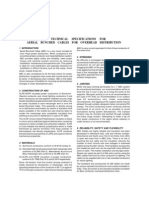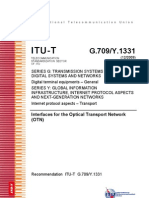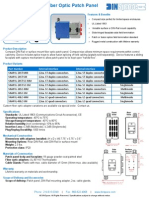Cat6 Cables
Cat6 Cables
Uploaded by
hvananthCopyright:
Available Formats
Cat6 Cables
Cat6 Cables
Uploaded by
hvananthOriginal Title
Copyright
Available Formats
Share this document
Did you find this document useful?
Is this content inappropriate?
Copyright:
Available Formats
Cat6 Cables
Cat6 Cables
Uploaded by
hvananthCopyright:
Available Formats
Category 6 cable - Wikipedia, the free encyclopedia
Page 1 of 3
Category 6 cable
From Wikipedia, the free encyclopedia
Category 6 cable, commonly referred to as Cat 6, is a cable standard for Gigabit Ethernet and other network protocols that is backward compatible
with the Category 5/5e and Category 3 cable standards. Cat-6 features more stringent specifications for crosstalk and system noise. The cable standard
provides performance of up to 250 MHz and is suitable for 10BASE-T / 100BASE-TX and 1000BASE-T (Gigabit Ethernet). It is expected to suit the
10GBASE-T (10Gigabit Ethernet) standard, although with limitations on length if unshielded Cat 6 cable is used.
The cable contains four twisted copper wire pairs, just like earlier copper cable standards. Although Cat-6 is sometimes made with 23 gauge wire, this is
not a requirement; the ANSI/TIA-568-B.2-1 specification states the cable may be made with 22 to 24 AWG gauge wire, so long as the cable meets the
specified testing standards. When used as a patch cable, Cat-6 is normally terminated in 8P8C modular connectors, often incorrectly referred to as "RJ45" electrical connectors. Cat-6 connectors are made to higher standards that help reduce noise caused by crosstalk and system noise. Attenuation,
NEXT (Near End Crosstalk), and PSNEXT (Power Sum NEXT) are all significantly lower when compared to Cat-5/5e.
Some Cat-6 cables are too large and may be difficult to attach to 8P8C connectors without a special modular piece and are technically not standard
compliant. If components of the various cable standards are intermixed, the performance of the signal path will be limited to that of the lowest category.
As with all cables defined by ANSI/TIA/EIA-568-B, the maximum allowed length of a Cat-6 horizontal cable is 100 meters (330 ft) in length,
depending upon the ratio of cord length:horizontal cable length.
The cable is terminated in either the T568A scheme or the T568B scheme. It doesn't make any difference which is used, as they are both straight
through (pin 1 to 1, pin 2 to 2, etc). Mixing T568A-terminated patch cords with T568B-terminated horizontal cables (or the reverse) does not produce
pinout problems in a facility. Although it may very slightly degrade signal quality, this effect is marginal and certainly no greater than that produced by
mixing cable brands in-channel. The T568B Scheme is by far the most widely used method of terminating patch cables.
Crossover is used for hub to hub, computer to computer, wherever two-way communication is necessary. All gigabit ethernet equipment, and most new
10/100Mb equipment, supports automatic crossover, meaning that either a straight-through or crossover cable may be used for any connection.
However, older equipment requires the use of a straight-through cable to connect a switch to a client device, and a crossover cable to connect a switch to
a switch or a client to a client. Crossover cables can be constructed by wiring one end to the T568A scheme and the other end with the T568B scheme.
This will ensure that the Transmit (TX) pins on both ends are wired through to the Receive (RX) pins on the other end.
8P8C Wiring (TIA/EIA-568A T568A)
8P8C Wiring (TIA/EIA-568B T568B)
http://en.wikipedia.org/wiki/Category_6_cable
18/03/2008
Category 6 cable - Wikipedia, the free encyclopedia
Pin Pair Wire
1
Color
white/green
green
white/orange
blue
white/blue
orange
white/brown
brown
Pin Pair Wire
1
Page 2 of 3
Color
white/orange
orange
white/green
blue
white/blue
green
white/brown
brown
Augmented Category 6 (Category 6a)
The TIA is working to complete a new specification that will define enhanced performance standards for unshielded twisted pair cable systems. Draft
specification ANSI/TIA/EIA-568-B.2-10 specifies cable systems, called "Augmented Category 6" or more frequently as "Category 6a", that operate at
frequencies up to 500 MHz and will provide up to 10 Gbit/s bandwidth. The new specification has limits on alien crosstalk in cabling systems.
Augmented Category 6 specifies cable operating at minimum frequency of 500 MHz, for both shielded and unshielded. It can support future 10 Gbit/s
applications up to the maximum distance of 100 meters on a 4-connector channel.
Retrieved from "http://en.wikipedia.org/wiki/Category_6_cable"
Categories: Ethernet | Networking hardware | Signal cables
http://en.wikipedia.org/wiki/Category_6_cable
18/03/2008
Category 6 cable - Wikipedia, the free encyclopedia
Page 3 of 3
Hidden categories: Articles lacking sources from February 2008 | All articles lacking sources
This page was last modified on 27 February 2008, at 21:39.
All text is available under the terms of the GNU Free Documentation License. (See Copyrights for details.)
Wikipedia is a registered trademark of the Wikimedia Foundation, Inc., a U.S. registered 501(c)(3) taxdeductible nonprofit charity.
http://en.wikipedia.org/wiki/Category_6_cable
18/03/2008
You might also like
- Dow Chemicals Safety ManualDocument511 pagesDow Chemicals Safety ManualhvananthNo ratings yet
- Ethernet Cable: Types, Performance & Pinout - Cat 5, 5e, 6, 6a, 7, 8Document7 pagesEthernet Cable: Types, Performance & Pinout - Cat 5, 5e, 6, 6a, 7, 8blackravenNo ratings yet
- Cara Nak Pasang Wayar Cats Eye Utk NetworkDocument15 pagesCara Nak Pasang Wayar Cats Eye Utk NetworkKrull Hzm100% (1)
- Cat 6 UTP PVC Cable Belden 7965E: ConstructionDocument2 pagesCat 6 UTP PVC Cable Belden 7965E: ConstructionNishathFarvizNo ratings yet
- UTP CAT 6 Cable 020402Document1 pageUTP CAT 6 Cable 020402yuswmaNo ratings yet
- UTP Cat.6ADocument6 pagesUTP Cat.6Adelly murtiNo ratings yet
- 2-7-Totally Gel-Free Fiber Optical Cables Manufactured With PBTDocument6 pages2-7-Totally Gel-Free Fiber Optical Cables Manufactured With PBTDursunNo ratings yet
- Twisted Pair CablesDocument26 pagesTwisted Pair Cablesnaleengt100% (1)
- A Leading Manufacturer of Instrumentation Cables Eng 287827Document24 pagesA Leading Manufacturer of Instrumentation Cables Eng 287827priyanka236No ratings yet
- 2.1. Technical Specification For OPGW NZ (91271A (Rev.3) )Document9 pages2.1. Technical Specification For OPGW NZ (91271A (Rev.3) )Samiksha BhattacharyaNo ratings yet
- Wire and Cable Extrusion SystemsDocument8 pagesWire and Cable Extrusion Systemsanindya19879479No ratings yet
- ENA ER G81 Part 5 Issue 1 Amendment 1 080109Document14 pagesENA ER G81 Part 5 Issue 1 Amendment 1 080109Radulescu AndreiNo ratings yet
- En-Fiber Optic Pre-Connectorized SolutionDocument44 pagesEn-Fiber Optic Pre-Connectorized SolutionbashkimNo ratings yet
- Cables: Dr. Mohamed Gamal H.AshmawyDocument29 pagesCables: Dr. Mohamed Gamal H.AshmawyMohamed Khalid R. JubaraNo ratings yet
- 【GL】ADSS-24 coreDocument7 pages【GL】ADSS-24 coreAlex GonzalesNo ratings yet
- Fiber Optic CommunicationDocument4 pagesFiber Optic Communicationeaglett100% (1)
- Cat 6 UTP Outdoor Cable 1427319-1Document2 pagesCat 6 UTP Outdoor Cable 1427319-1Khairul AnuarNo ratings yet
- TM 2G3G4G Hardware Installation Guide V1.6 PDFDocument150 pagesTM 2G3G4G Hardware Installation Guide V1.6 PDFjacobus_louw4329No ratings yet
- ZTT Adss 20-113931 - BDocument11 pagesZTT Adss 20-113931 - BervanNo ratings yet
- Cable Tray SystemsDocument7 pagesCable Tray SystemsRane SiddeshNo ratings yet
- Cold Shrink TubeDocument4 pagesCold Shrink TubeezioNo ratings yet
- Ethernet WiringDocument3 pagesEthernet WiringIs Oonly0% (1)
- PDF HT-XLPEDocument36 pagesPDF HT-XLPEKvj SrinivasaraoNo ratings yet
- RGS Catalogue PDFDocument28 pagesRGS Catalogue PDFVander OliveiraNo ratings yet
- Ensto Overhead Line Networks SolutionsDocument92 pagesEnsto Overhead Line Networks SolutionsDilip79No ratings yet
- Trefoil and Single Cable Cleats Type SmartcleatDocument12 pagesTrefoil and Single Cable Cleats Type SmartcleatfndprojectNo ratings yet
- How Cable Modems WorkDocument6 pagesHow Cable Modems WorkboyetcincoNo ratings yet
- Aci Lhs 110 230 Ul Listed Lhs CableDocument16 pagesAci Lhs 110 230 Ul Listed Lhs CableDipanjan PolleyNo ratings yet
- Wind GGGGGGGGGGDocument13 pagesWind GGGGGGGGGGKarthikeyan PanchatcharamNo ratings yet
- CableInstallation PDFDocument8 pagesCableInstallation PDFJAY PARIKHNo ratings yet
- Special CablesDocument57 pagesSpecial CablesNael Hajjar100% (1)
- Yokogawa AQ7270 Series OTDR Manual PDFDocument328 pagesYokogawa AQ7270 Series OTDR Manual PDFcesargo_3185706No ratings yet
- Arial Bunch ConductorDocument10 pagesArial Bunch Conductorbbakari2000No ratings yet
- Signal Transmission SystemsDocument19 pagesSignal Transmission SystemsNipu EkanayakeNo ratings yet
- LAN CableDocument7 pagesLAN CableBhavesh KeraliaNo ratings yet
- Siemens Mto Item No.: A3 Power Cable: 2C X 16 MM CU/XLPE/PVC, UnarmouredDocument16 pagesSiemens Mto Item No.: A3 Power Cable: 2C X 16 MM CU/XLPE/PVC, UnarmouredrhomadonaNo ratings yet
- Opgw Fiber Spec Dno 91391Document5 pagesOpgw Fiber Spec Dno 91391carlos diazNo ratings yet
- YBS ElevatorCables PDFDocument4 pagesYBS ElevatorCables PDFYBS CablesNo ratings yet
- Cable Lugs and ConnectorsDocument74 pagesCable Lugs and Connectorsismail alwainiNo ratings yet
- 24 Fiber OPGW ANDES PDFDocument7 pages24 Fiber OPGW ANDES PDFMAN TNo ratings yet
- Caledonian Rolling Stock CablesDocument108 pagesCaledonian Rolling Stock CablesNiki FuNo ratings yet
- 1 Day OFC ContentDocument154 pages1 Day OFC ContentPranav PrabhakarNo ratings yet
- Parker 7321B/ 7322B Series Water ValvesDocument24 pagesParker 7321B/ 7322B Series Water ValvesKambiz ZahedNo ratings yet
- Itu T-Rec-G.709-2009Document218 pagesItu T-Rec-G.709-2009dennisczhou8698No ratings yet
- Part Number External Interface Internal Interface Fiber Optic WavelengthDocument1 pagePart Number External Interface Internal Interface Fiber Optic WavelengthhashiktmNo ratings yet
- Introduction To BroadbandDocument7 pagesIntroduction To BroadbandAbhishek DebNo ratings yet
- Rdso Spec For STP Clause 5.15.9.1Document48 pagesRdso Spec For STP Clause 5.15.9.1sinhavivek12897No ratings yet
- A Guide To Wire and Cable ConstructionDocument24 pagesA Guide To Wire and Cable Constructiondjohnson78100% (1)
- PROLINE Linear Heat Sensor Cables.Document2 pagesPROLINE Linear Heat Sensor Cables.Germán EspinozaNo ratings yet
- Toshiba Smart Grids To Realize Advanced Energy ManagementDocument4 pagesToshiba Smart Grids To Realize Advanced Energy ManagementAsian Development BankNo ratings yet
- SPECIFICATION - PEEK Coaxial CablesDocument20 pagesSPECIFICATION - PEEK Coaxial CablesAbhimanyu Singh ChauhanNo ratings yet
- Chapter 2. Fundamentals of Ethernet LANsDocument27 pagesChapter 2. Fundamentals of Ethernet LANsPoojitha NagarajaNo ratings yet
- Cellular Technologies for Emerging Markets: 2G, 3G and BeyondFrom EverandCellular Technologies for Emerging Markets: 2G, 3G and BeyondNo ratings yet
- Patch Cord Wiring Guide: Technical ReferenceDocument5 pagesPatch Cord Wiring Guide: Technical ReferencejoalsajuNo ratings yet
- RJ 45 PinoutsDocument6 pagesRJ 45 Pinoutstheeeclipse17No ratings yet
- Ethernet Cables Rev 1-MedlockDocument18 pagesEthernet Cables Rev 1-MedlockDA MVNo ratings yet
- Category 1 CableDocument8 pagesCategory 1 CableNelsen MarcelinoNo ratings yet
- Category 5 Cable: From Wikipedia, The Free EncyclopediaDocument4 pagesCategory 5 Cable: From Wikipedia, The Free EncyclopediahvananthNo ratings yet
- TIA/EIA-568-B Is A Set of ThreeDocument5 pagesTIA/EIA-568-B Is A Set of ThreeGhe PataniNo ratings yet
- Cat5e Cable Wiring Schemes: White Paper SeriesDocument4 pagesCat5e Cable Wiring Schemes: White Paper Seriesp_c@igNo ratings yet
- Ethernet Cable TypesDocument16 pagesEthernet Cable TypesSumant KumarNo ratings yet
- Alarm Prioritazion Safety MomentDocument2 pagesAlarm Prioritazion Safety MomenthvananthNo ratings yet
- Yokogawa India Work Procedure: RevisionsDocument5 pagesYokogawa India Work Procedure: RevisionshvananthNo ratings yet
- 09.SIS ChecklistDocument38 pages09.SIS ChecklisthvananthNo ratings yet
- Hazop Training PresentationDocument72 pagesHazop Training Presentationhvananth100% (2)
- PCIC Europe 2017 Cyber Security Tutorial Energy Automation and Iec 62443Document55 pagesPCIC Europe 2017 Cyber Security Tutorial Energy Automation and Iec 62443hvananthNo ratings yet
- Security Assurance Levels: A Vector Approach To Describing Security RequirementsDocument13 pagesSecurity Assurance Levels: A Vector Approach To Describing Security RequirementshvananthNo ratings yet
- Blowout Frequencies: Risk Assessment Data DirectoryDocument20 pagesBlowout Frequencies: Risk Assessment Data DirectoryhvananthNo ratings yet
- Challenges 62443Document18 pagesChallenges 62443hvananthNo ratings yet




































































